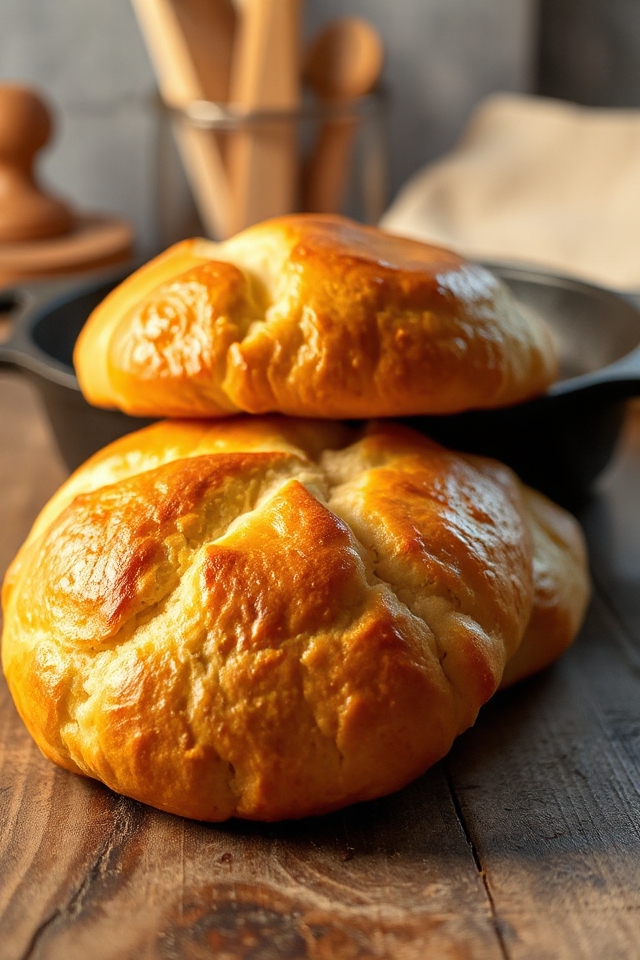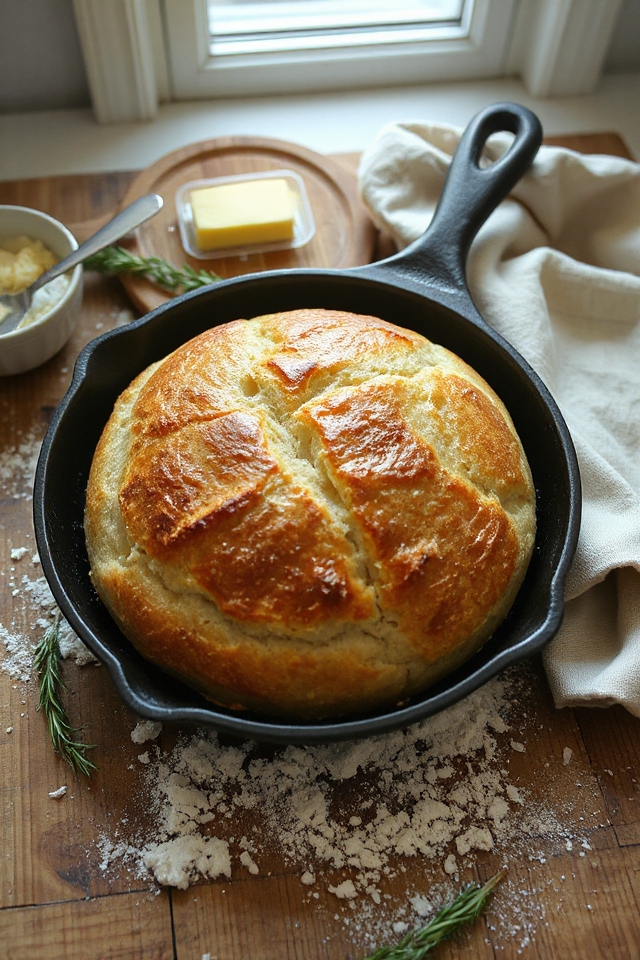Why You’ll Love This Skillet Bread Recipe
When you try this skillet bread recipe, you’ll discover how simple and rewarding it’s to make fresh bread at home.
I love how quickly it comes together, with just a few basic ingredients. The aroma of warm, golden loaves fills my kitchen, making it feel cozy and inviting.
Each bite is soft and slightly crispy, offering a delightful contrast in texture. Plus, it’s incredibly versatile; you can serve it with soups, stews, or even enjoy it on its own.
Once you make this bread, you’ll wonder why you ever settled for store-bought. Trust me, you’ll be hooked!
Ingredients of Skillet Bread
When it comes to making skillet bread, the best part is that you probably already have most of the ingredients in your pantry. It’s a straightforward recipe that doesn’t require any fancy equipment or techniques—just a good old skillet and a bit of elbow grease.
So, roll up your sleeves and get ready to whip up something delightful. You’ll be amazed at how a handful of simple ingredients can transform into warm, delicious bread that can elevate any meal.
Here’s what you’ll need to gather:
- 5 cups of flour
- 2 tablespoons of baking powder
- 1 teaspoon of salt
- 1 tablespoon of melted butter or margarine
- 2 cups of milk
- Cooking oil (for frying the bread)
Now, let’s chat a bit about these ingredients. Flour is the backbone of any bread recipe, and in this case, it’s the foundation that gives our skillet bread its structure. You can use all-purpose flour, which works perfectly.
Baking powder is your magic leavening agent, giving the bread a nice rise, while salt adds that essential flavor boost—no one wants bland bread, right? As for the butter or margarine, it brings richness to the dough, making it tender and tasty.
And then there’s the milk, which not only hydrates the flour but also contributes to that soft texture we all love. Don’t forget the oil for frying; it’s what gives the bread that lovely golden crust.
How to Make Skillet Bread

Making skillet bread is a delightful adventure, and trust me, it’s easier than you might think. First, you’ll want to start by sifting together 4 cups of flour, 2 tablespoons of baking powder, and 1 teaspoon of salt in a large bowl. This step is super important because sifting aerates the flour and makes for a lighter bread.
While you’re at it, let’s not forget about the 1 tablespoon of melted butter or margarine; combine that with 2 cups of milk in a separate bowl. You can use a whisk or even a fork—no fancy gadgets needed. Just make sure everything is nicely blended and ready to join the flour party.
Now, here’s where the magic begins. Gradually add your milk and butter mixture to the flour mix, stirring as you go. You want to beat it well until you have a soft dough. If it’s sticking like a toddler to a toy, sprinkle a little more flour—up to 1 cup of the remaining flour should do the trick.
Then, plop that dough onto a lightly floured surface. Knead it gently; don’t go all-out like you’re in a bread wrestling match. Just a light knead will do. After that, divide the dough into three parts and shape each into a round pone about 1/8 inch thick, making sure they fit your skillet.
While you’re shaping those pones, heat up a skillet with enough cooking oil to measure about 1/4 inch deep. You want it hot enough for frying but not so hot that it feels like a trip to the dentist.
Once the oil is sizzling, carefully place each loaf in the skillet, frying them one at a time until they turn a beautiful golden brown on both sides. This part is like watching your favorite movie—exciting and a little nerve-wracking. Remember to keep an eye on them; nobody wants burnt bread.
And just like that, you’ve created skillet bread that’s not only fun to make but also perfect for sharing. So, who’s ready for a warm slice?
Skillet Bread Substitutions & Variations
After whipping up a batch of that delicious skillet bread, you might find yourself wanting to switch things up a bit.
I love experimenting with different flours, like whole wheat or spelt, for a nuttier flavor. You can also add herbs, such as rosemary or thyme, for a fragrant twist.
If you’re feeling adventurous, try incorporating cheese or sautéed onions into the dough. For a sweeter version, mix in honey, cinnamon, or dried fruits.
And don’t hesitate to adjust the milk with buttermilk or a non-dairy alternative. There’s so much fun to be had in making skillet bread your own!
Additional Tips & Notes
While you’re preparing to make skillet bread, keep in mind a few tips to enhance your baking experience.
First, make certain your oil is hot enough; a drop of dough should sizzle upon contact. I recommend using a cast-iron skillet for even heat distribution.
If you want a richer flavor, try adding herbs or cheese to the dough. Also, don’t skip kneading lightly; it helps develop the texture.
Finally, let the bread cool slightly before cutting to maintain its shape. Enjoy experimenting with different toppings or spreads to elevate your skillet bread to the next level!
